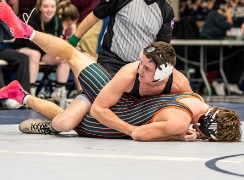Boy Scouts take on journalism with help of county businesses
Last Thursday morning the temperature at Camp Pellissippi was 18-degrees at 8 a.m.
It was a hard morning to come out bright eyed and bushy tailed.
But they did.
Seven Boy Scouts, one coming from as far away as Southern Illinois, attended a journalism class in pursuit of a journalism merit badge.
It was part of the Scout’s annual winter “camp out” where classes were held to help earn merit badges in everything from cooking to wood working to first aid.
And journalism, which I happened to be teaching on that cold morning.
Luckily (or unluckily) the class was held inside the winter lodge where meals were served. Which meant warmth.
Unluckily because after spending the night in below-freezing temperatures, then a large hot breakfast, some of the Scouts were … A little sleepy?
So, I did what a journalist does: I asked them questions.
Got some interesting answers, particularly when I asked them why they wanted a journalism badge.
The answers ranged from learning writing skills to how is news gathered to wanting to know the best way to follow what’s happening in their community.
But they all wanted to learn. And get the merit badge.
All but one scout is a member of the Great Smoky Mountain Council.
Vencent Beaty, a 14-year-old from near Carbondale, Ill., is a member of the Greater St. Louis Area Council. Beaty was attending the winter camp with his father.
“We drove about six hours to be here,” he said. “We could have gone to another camp out but this one has some courses not offered at the others.”
Johnathan Ford, who is working on his Eagle Scout rank, originally hails from Long Island, N.Y., and now lives in Cumberland County, said the winter camps are excellent — though cold — for working toward merit badges.
He took the journalism course to help him write more cohesively.
Trace Nystrom, a student at Webb Middle School, signed up because he’s familiar with Anderson County and hoped to be able to write about an event here.
And that is part of the class — in this case a visit to the Museum of Appalachia — where Will Meyer donated part of his day to answer questions for the Scouts.
Meyer told the history of the museum, founded by his grandfather, John Rice Irwin, and about the events throughout the year. The annual “Anvil Shoot” seemed to draw the most attention.
Nystrom had a couple of surprises up his sleeve for Meyer, asking if the Museum still had the “glass eye.”
The eye was donated to the museum from a man who, as a boy, lost his eye in a freak knife accident.
He also asked Meyer about a chest in the conference room that had the Mason’s symbol etched into the doors. Something Meyer hadn’t noticed before.
“Usually granddad has a card or something in the drawers to tell about the piece,” Meyer explained.
After talking with Meyer the Scouts spent a lot of time outside the museum checking out the peacocks.
After visiting the Museum of Appalachia the scouts hit The Courier News office, getting a quick tour of the facility and then sat down to write a story about their visit to the museum.
The scouts had to complete two basic functions of writing news.
• Learn the “inverted pyramid” style for writing a news story, where the important facts are in the first two or three paragraphs.
• Include the five Ws and the one H in the first part of the story: What, When, Where, Why, and Who; and How.
All seven did just that.
And some did a little more.
Lucas D’Cruz remembered a little tidbit about every news story should have art work.
With limited resources (not all scouts carried cell phones to the camp out), D’Cruz drew pictures for his story: One of a peacock and one of the entrance to the Museum of Appalachia.
Cody Vogel didn’t use pictures, but did pick up a little something about newspaper layout when he completed his story complete with space for advertising.
It was interesting to see what each scout took away from their interview with Meyer and their trip to The Courier News.
Six of the scouts wrote about an aspect of the museum they had learned about.
Vencent Beaty wrote about the history of the museum.
Johnathan Ford wrote about the many events held at the museum.
Samuel Rankin wrote about the food preparation at the museum.
Cody Vogel wrote about the numerous animals kept at the museum and about sheep shearing.
Trace Nystrom wrote about the many exhibits at the museum, including “The Glass Eye.”
D’Cruz wrote about the peacocks at the entrance to the museum and how they seemingly greeted visitors.
Jacob Turnmire wrote about the history of The Courier News and First Amendment rights.
A lot of material was covered, and it was surprising to see what each scout retained and used in their story.
I learned a couple of interesting things. The scouts I worked with Thursday are well adjusted and intelligent. None of them have a Facebook page or use Twitter. They get their news from newspapers or from internet news sites that cater to a specific niche, or if there is a specific topic that will have more background articles.
At the end of the day I asked them one question: “Did you have fun?”
I then gave them two pieces of advice: Enjoy whatever you choose to do in life; and remember there is no such thing as a dumb question.
And then (would you expect less?) they shook my hand and thanked me.

